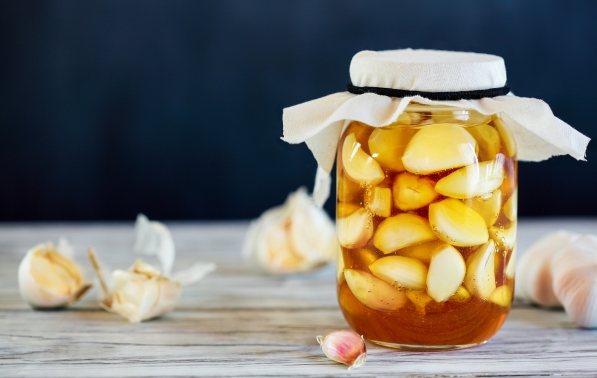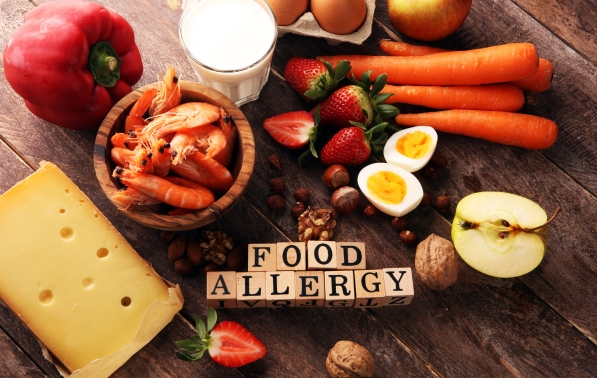Herb Profile: Garlic
April 25, 2024 | 0 comments
by Wendy Wilson
This aromatic bulb has been hailed for its potential to combat ailments ranging from infections to cardiovascular issues, earning it the title of "nature's antibiotic" in many circles.
Garlic, revered not only for its culinary allure but, also for its medicinal properties, has long been celebrated across various cultures and civilizations throughout history. From ancient Egyptian remedies to medieval European tinctures, garlic has maintained a prominent place in traditional medicine practices worldwide. This aromatic bulb has been hailed for its potential to combat ailments ranging from infections to cardiovascular issues, earning it the title of "nature's antibiotic" in many circles. Keep reading for how garlic can be used as a tool to strengthen and combat common ailments.
WHY YOU NEED GARLIC
The written medicinal benefits of garlic date back to the Ancient Egyptians during the time the pyramids were being built. Garlic kept the slaves healthy, and Pharaohs ensured they had plenty of garlic, leeks, and onions. French gravediggers in the 18th century used garlic internally to protect them from plagues. During WW I & II garlic was given to American soldiers to prevent gangrene. Since then numerous studies have been done on garlic's medicinal power to keep us healthy. So, if you want protection against diseases it’s a no-brainer to reach for garlic.
SCIENCE STAKES CLAIM
Modern medicine doesn’t have all the answers to why garlic has been proven to reduce cholesterol, help with high blood pressure, offer protection against cancer, and boost our immune system. What science reports to know about garlic is that it provides antioxidants to protect our cell membranes from damage and aids in deterring aging. Most scientific trials on garlic were performed with an aged garlic extract, dried garlic tablets, or enteric-coated garlic tablet (a tablet coated with a substance to delay the release of the medicinal properties until it has passed through to the small intestine). Reports on garlic’s ability to decrease cardiovascular disease, lower cholesterol, and blood pressure have been in the mainstream media. In the lab, the common cold has also been under attack by garlic. Studies showed that those taking medicinal amounts of garlic during the flu season had fewer colds and shorter recovery times when sick.
GARLIC & CANCER
Nearly one-third of all the garlic studies are cancer-related. There was a large study called the Women’s Health Study, in which garlic, fruit, and vegetables were used in 41,000 middle-aged women. The study concluded that regular consumption of these foods lowered the risk of cancer by 35%. The study also noted that those who eat raw garlic are less likely to develop colon and stomach cancer. There are approximately seven major studies on garlic in which researchers discovered there was a 30% reduced risk of developing colon-rectal cancer when using garlic. The researchers also believed that raw garlic offered some protection against breast, prostate, and throat cancer. One study looked at the improvement patients had when taking garlic while undergoing chemotherapy. Their immune system was stronger and the side effects of fatigue and lack of appetite were reduced and simultaneously protected the heart and intestines against damage from the toxic agents used in chemotherapy. Researchers also found that when they looked at fifty patients with inoperable cancers (colon-rectal, pancreatic, or liver) there was overall improved immune system function when taking an aged garlic tincture for six months.
OTHER DISCOVERIES
Lots of animal studies on garlic show what a miracle this herb is. If you use enough garlic, it will rid you of roundworms (intestinal parasites). It has strong antibacterial and antifungal properties and is extremely helpful with ulcers (internal and external). A majority of the benefit in garlic comes from the alliin in it (sulfur compound) and is believed to be the medicinal property that assists with reducing cholesterol, heart disease, and cancer. Herbalists have known for centuries that garlic helps with lowering blood sugar, blood pressure, and blood lipids, helps rid the body of bronchial secretions, stimulates the liver, pancreas, and bile production as well as improves urine flow.
PRECAUTIONS
It is not recommended to use medicinal amounts of garlic with prescription medications such as antiplatelet drugs (Plavix, aspirin, dipyridamole, indomethacin), anticoagulants (warfarin, aspirin), and protease inhibitors (immune deficiency drugs for HIV such as indinavir).
POOR MAN’S ANTIBIOTIC
Some herbs are great at stimulating the immune system to work such as Echinacea root but, garlic is a potent herb used to kill pathogens (the agents of disease such as a micro-organism or bacterium). This is why garlic can help the body reverse diseases such as cancer. If you had to select only one herb – our choice would be garlic.
Garlic has broad-spectrum action on most pathogens and it is often referred to as a natural antibiotic. Our bodies have millions of bacteria, with some of them being necessary for metabolic functions (good bacteria). The problem with pharmaceutical antibiotics is that they are not selective and kill 99% of the bacteria (friendly and non-friendly). The one percent it doesn’t kill mutates, becomes drug-resistant, and encourages yeast to grow. Garlic on the other hand is selective targeting only non-friendly bacteria. Garlic also encouraged the friendly bacteria to improve intestinal flora and digestion. Modern medicine has run out of antibiotics for drug-resistant strains of MRSA (staphylococcus), streptococcus, diphtheria, cholera, bacterial dysentery (a.k.a. Traveler’s diarrhea), tuberculosis, tetanus, rheumatic bacteria, and other bacterial strains.
WHAT YOU MAY NOT KNOW
Garlic has been tested in the lab and it kills many different bacterial strains including the ones mentioned above. It also kills measles, mumps, Epstein-Barr, chicken-pox, herpes simplex 1 & 2, herpes zoster, viral hepatitis, scarlet fever, and rabies. There are other pathogens that it kills and the list is quite long. The secret to using garlic against powerful diseases is to use it raw (uncooked) and use a lot of it. Garlic tinctures qualify as uncooked if they are aged and cold-pressed. Antifungal drugs such as Nystatin can’t outperform garlic’s proven ability to destroy fungus. Garlic even helps regulate any Candida to prevent an overgrowth. Ringworm does not stand a chance against garlic. One of the reasons garlic is so effective against cancer is that it assists with white blood cells to defend against cancer, destroy tumors, and reduce pain associated with cancer.
GARLIC IN THE BLOOD
When you have garlic running through your veins you have magnified the power of your immune system tenfold. If you plan to use raw cloves of garlic make sure it is not a hybrid garlic and preferably organic. We recommend consuming one whole clove per day to start and use cloves that are at least one inch long. You can chop them up and put them on your salad, include them in your vegetable juice, or add it to your salsa – there are many ways to use raw garlic. If you are sick, your goal is to work your way up to three cloves per day. Most of the clinical studies saw significant improvement when three cloves of garlic were consumed per day. Garlic has a unique aroma but we can deal with a garlic smell if it will save us from disease or worse.
OTHER USES
Garlic contains sulfuric acid and will burn through the skin. I like to take advantage of this fact and apply lots of fresh, raw garlic to warts, boils, and cancer and burn them off. Below we have included a recipe to use for warts, boils, or cancer spots that can be applied topically to the skin.
WART, BOIL, SMALL CANCER POULTICE
You can put the following in a blender with 50% water & 50% apple cider vinegar and make a paste:
1 cup red clover blossom
1 whole bulb of garlic (about 12 cloves - peel off paper first)
1/3 cup dried poke root
2 tablespoons of goldenseal root
1 cup slippery elm inner bark
1 tsp of tea tree oil (optional)
1 ounce of bloodroot tincture (if you have it) to 8 ounces of poultice liquid
This is also good for skin cancer (melanoma). Leave it on all night and wash it off in the morning. Repeat 6 nights out of 7 until desired results appear. You can also apply during the day for severe conditions. You can massage the skin with castor oil or olive oil after removing the poultice. You can take daily photos to compare progress.
GARLIC TINCTURES
If you are using an herbal tincture of garlic 1 to 2 drops is worth 8 to 16 ounces of dried garlic powder. It is much easier to deliver the antibacterial, antiviral, and antifungal power of garlic via a tincture. Tinctures that are naturally aged and made without heat will contain the highest potency and nutritional value. You will find organic, cold-pressed, and potent tinctures at Apothecary Herbs. Below is a full list of the products we offer that include garlic.
Garlic stands as a versatile and potent medicinal ally, mostly for its multifaceted benefits across cultures and centuries. From ancient civilizations to modern research, its therapeutic potential continues to be explored. Through its antimicrobial, anti-inflammatory, and cardiovascular support properties, garlic offers a natural and accessible means of promoting health and well-being. Whether consumed raw, cooked or in supplement form, harnessing the power of garlic is a beneficial addition to one's wellness routine.
Sources:
https://www.sciencedaily.com/releases/2016/01/160121122158.htm
https://www.sciencedaily.com/releases/2009/01/090130154901.htm
https://www.sciencedaily.com/releases/2007/10/071016131534.htm
https://www.sciencedaily.com/releases/2019/09/190923155139.htm
https://www.sciencedaily.com/releases/2019/04/190408091259.htm
https://www.sciencedaily.com/releases/1998/11/981118080757.htm
https://www.sciencedaily.com/releases/2019/02/190221095057.htm
https://www.sciencedaily.com/releases/2018/04/180426130048.htm
https://www.sciencedaily.com/releases/2010/12/101216101833.htm
https://www.sciencedaily.com/releases/1997/10/971015054606.htm
https://www.sciencedaily.com/releases/2012/05/120501134203.htm
https://www.sciencedaily.com/releases/2000/10/001004072443.htm
https://www.sciencedaily.com/releases/2010/03/100301131905.htm
https://www.sciencedaily.com/releases/2014/11/141118105634.htm



